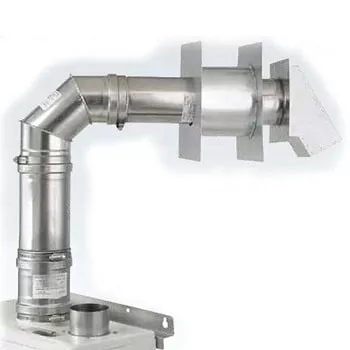
Are you looking to buy a new tankless water heater? When somebody asks how to vent a tankless water heater, they're probably asking what type of venting system should be installed. The work is pretty straightforward once you have a plan of attack. More or less, all you have to do is connect ductwork between the unit and the termination. So, what are your tankless water heating options? It boils down to three choices and deciding which is ideal for you:
- Direct-vent
- Power-vent
- You probably never thought of this option, and you're going to have to read the rest of the article to find out what it is.
Direct-Vent
A tankless water heater (like this Noritz EZ111DV-NG) with a direct-vent configuration requires two vents:
- An intake vent,
- and an exhaust vent.
The significant advantage of direct-vent is that you can install it in tighter spaces because it pulls in air from outside the house. However, direct-vent has constraints on where it can be installed within a building. If the installation point is a long, horizontal distance from the termination, direct-venting may not be feasible. You typically see direct-vent installations near exterior walls or the home's roof because of this fact. Where you won't tend to see them is on the bottom floor in the middle of a large commercial space.

Power-Vent
Power-vent installations need adequate air quantity, so they require more installation space. The major advantages of power-vent are that you only need one exhaust vent. With the power exhaust, the tankless water heater unit can effectively operate long distances from the termination point. So this is what you would install on the bottom floor in the middle of an ample commercial space if you have enough ambient air in that location.
Think Outside the Box (House) with Your Tankless Water Heater Venting Options!
Did you know that you can install an outdoor tankless water heater? This feasibly only makes sense in warmer climates. They're made with components that will protect them from the cold. If your water heater is installed outdoors, there is no need to vent anything. Problem solved!
Use Quality Components
Whatever you choose, be sure to use trusted brands for tankless water heaters, ductwork, and all the other parts and accessories that you may need to make this project happen. We have great deals on Bradford White, Noritz, and Takagi. Please contact us if you have any remaining questions about tankless venting options or anything relating to this topic.
Related resources:
How to Install a Tankless Water Heater
How to Flush a Tankless Water Heater
How to Reset a Tankless Water Heater



